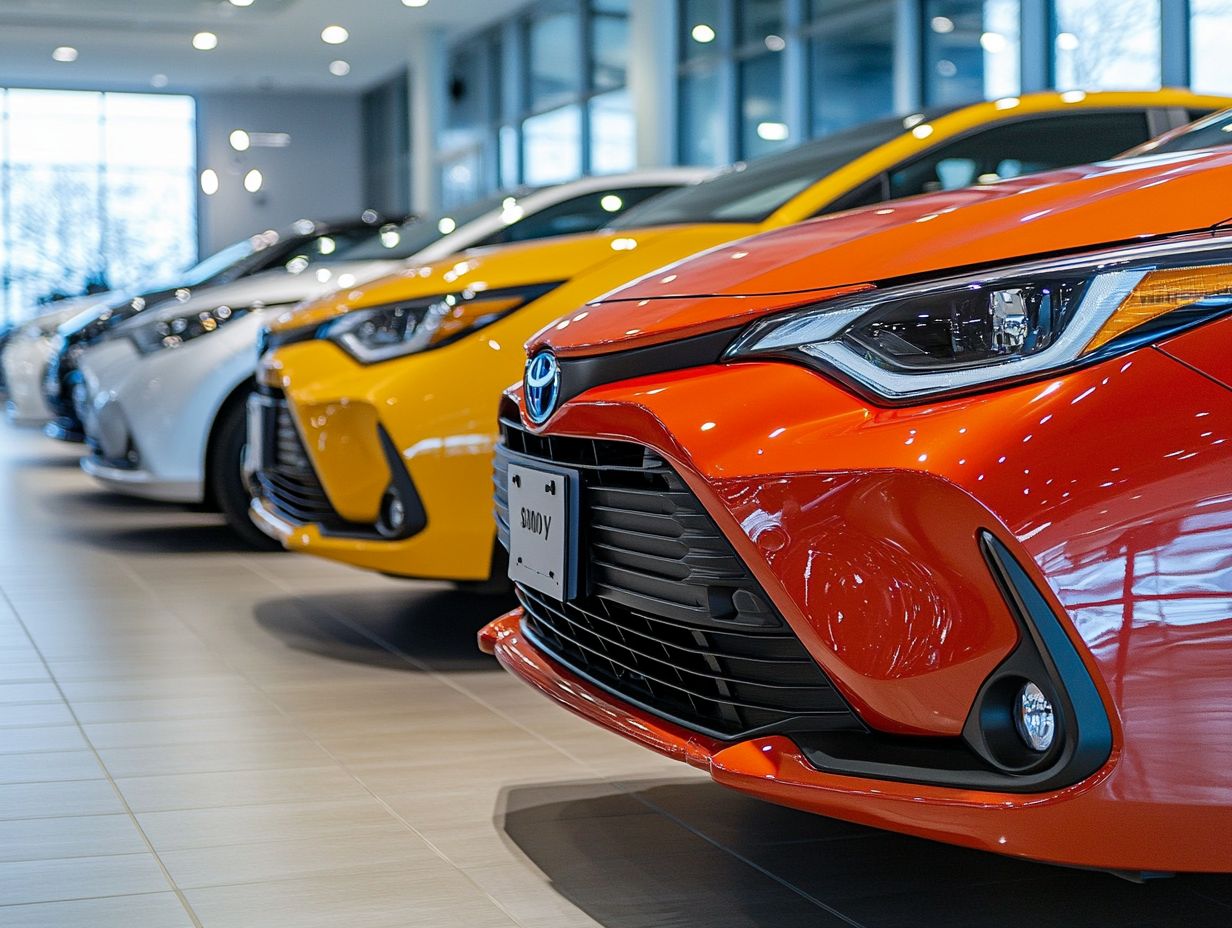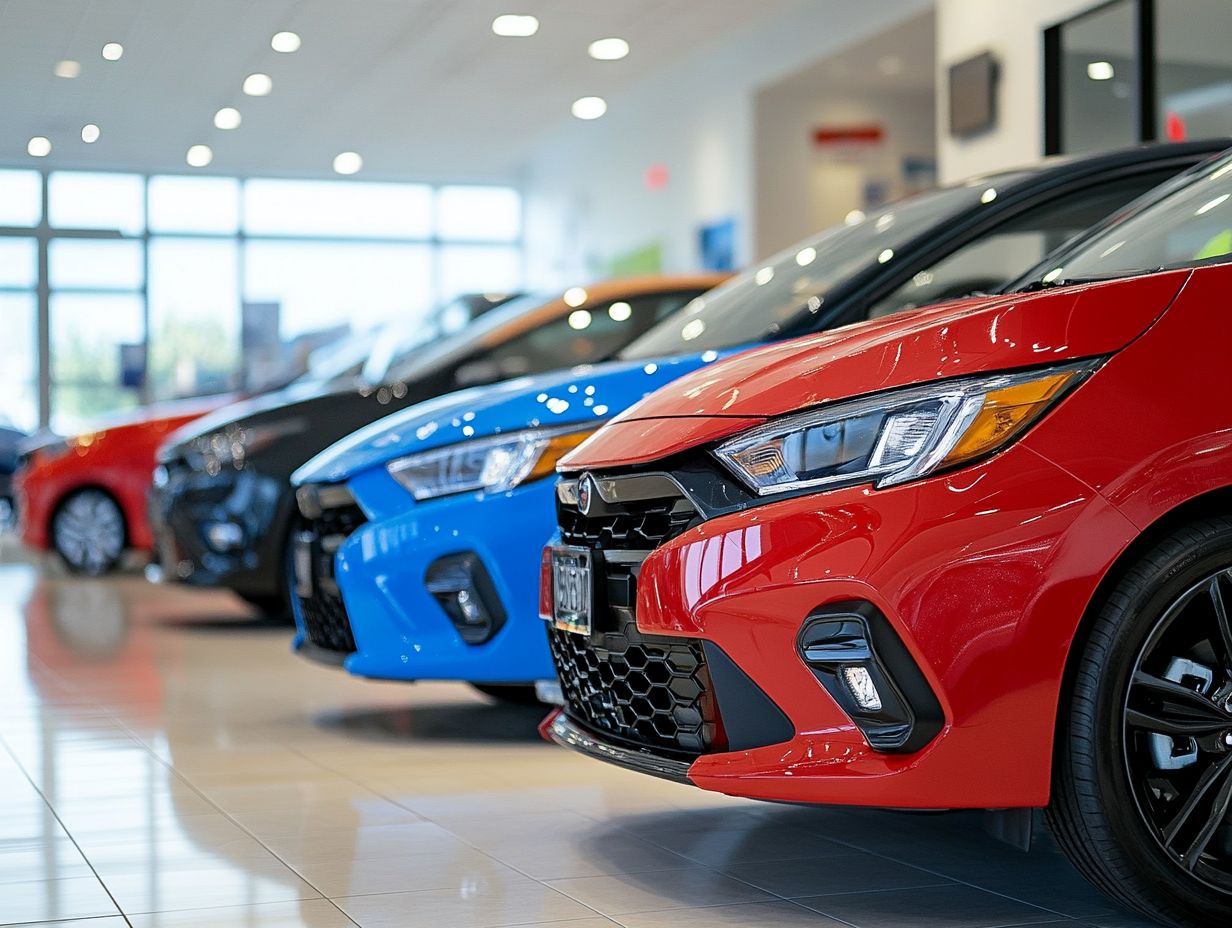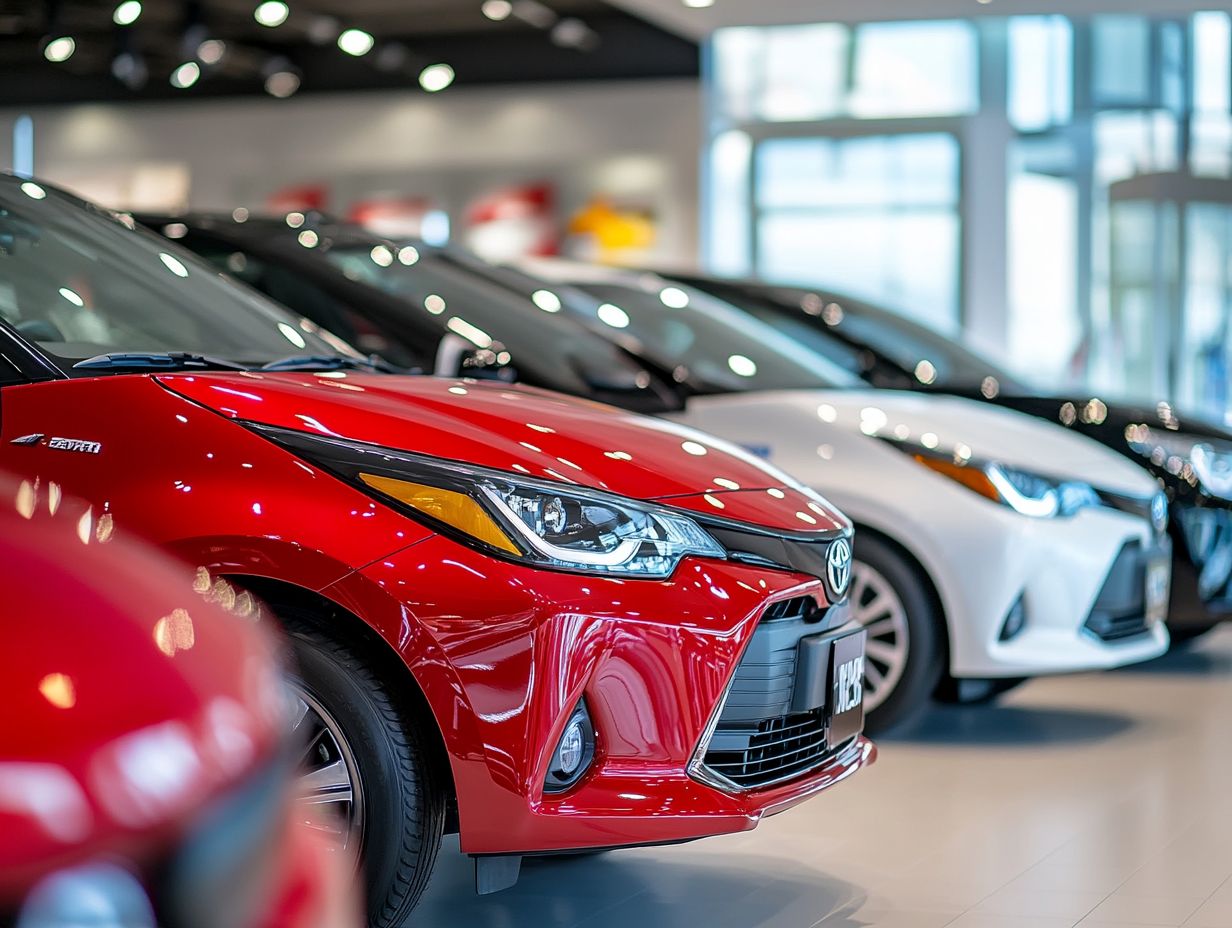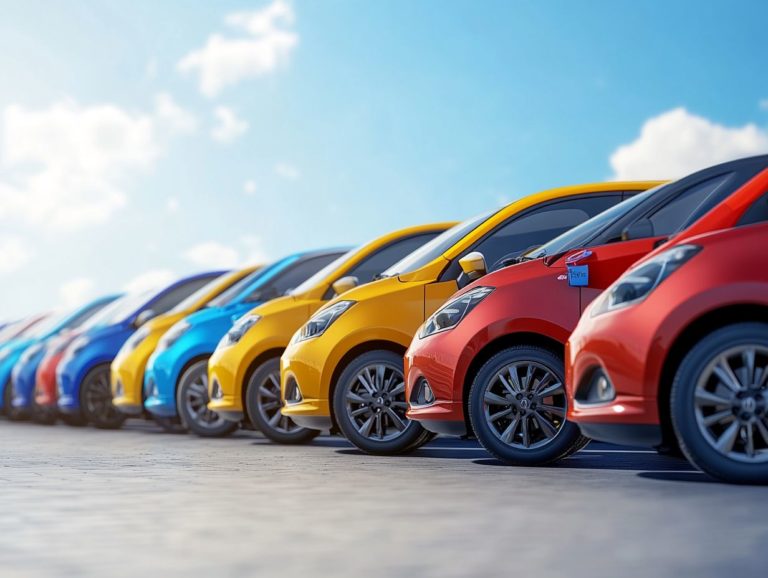Comparative Analysis: Economy Cars in 2024
As the automotive landscape evolves, economy cars are becoming increasingly appealing to consumers like you who seek affordability without compromising on quality.
This article delves into the defining characteristics of economy cars. We highlight the top models of 2024 and compare their features and performance.
It explores essential aspects such as cost of ownership, safety ratings, and environmental impact. These insights empower you to make informed decisions.
It also forecasts future trends that will shape economy cars. Are you ready to dive into the exciting world of budget-friendly vehicles?
Contents
- Key Takeaways:
- Defining Economy Cars and Their Market
- Top Economy Cars in 2024
- Cost of Ownership
- Safety Ratings and Features
- Environmental Impact of Economy Cars
- Future Trends in Economy Cars
- Frequently Asked Questions
- What is a comparative analysis of economy cars in 2024?
- What are some important factors to consider in a comparative analysis of economy cars in 2024?
- How will the economy car market evolve in 2024?
- Which economy cars are projected to be the top performers in 2024?
- How will the economy car segment be affected by global economic and environmental factors in 2024?
- What are some potential challenges for economy cars in 2024?
Key Takeaways:

- In 2024, top economy cars will offer a balance of performance, affordability, and fuel efficiency to meet the needs of cost-conscious consumers.
- When considering long-term costs of ownership, don’t forget to consider maintenance, repair, and fuel efficiency in addition to the initial purchase price.
- As the demand for environmentally-friendly vehicles grows, economy cars will continue to evolve in safety features, performance capabilities, and efforts to reduce carbon emissions.
Defining Economy Cars and Their Market
Economy cars, known for their affordability, fuel efficiency, and practicality, hold a crucial spot in the automotive market as you explore purchasing options in 2024.
With budget-friendly vehicles becoming more essential, these cars appeal to a diverse array of buyers. Whether you’re in the market for a brand-new model or considering options in the used car segment, there s something for everyone.
The competition among automakers think Ford, Stellantis, GM, and standout models like the Mitsubishi Mirage underscores the vibrant nature of this sector. It is shaped by supply, demand, and overarching economic trends.
Top Economy Cars in 2024
As you step into 2024, the landscape of economy cars is evolving to meet new consumer preferences, technological advancements, and the growing allure of electric vehicles. Automakers such as Ford, Stellantis, and GM, along with models like the Mitsubishi Mirage, are at the forefront, showcasing innovative features and competitive pricing.
Reports indicate that buyers like you are placing greater emphasis on quality, fuel efficiency, and sustainability in your car choices. This year stands as a crucial turning point for the automotive market, reflecting the shifting priorities of discerning drivers.
Features and Performance Comparison
When comparing economy cars, evaluate their features and performance metrics to pinpoint the best option for 2024. Key aspects like fuel efficiency, safety ratings, and technological innovations set models apart and significantly influence your purchasing decisions. For insight into the current landscape, consider reviewing the price trends in the automotive market for 2024.
As automakers adapt to shifting consumer preferences, you re likely looking for vehicles that offer reliability and incorporate modern technology to enhance your driving experience.
It s critical to scrutinize how various models stack up against one another. For instance, the 2024 Honda Civic boasts an impressive fuel efficiency rating of up to 36 mpg combined and emphasizes advanced safety features like Honda Sensing. Similarly, the Toyota Corolla shines with its superior reliability and an outstanding five-star safety rating from the NHTSA (National Highway Traffic Safety Administration), complemented by an intuitive infotainment system.
By focusing on these metrics, you can gain a clearer understanding of what each vehicle offers. This ensures your investment aligns seamlessly with your practical needs and modern expectations.
Cost of Ownership

Understanding the cost of ownership is essential for anyone considering investing in economy cars. It encompasses far more than just the initial purchase price.
Don’t forget to consider ways to pay for your car, insurance rates, maintenance expenses, and the potential for depreciation over time. By evaluating these long-term costs, you can make informed decisions that align with your budget and overall financial goals. This ensures a more rewarding ownership experience.
Factors to Consider for Long-term Costs
When evaluating the long-term costs associated with economy cars, consider several critical factors that can significantly influence your overall financial commitment. Maintenance expenses, insurance costs, and the vehicle’s depreciation rate are all key elements that can vary widely between different models and makes. Analyzing these aspects helps you assess your potential return on investment and select a vehicle that aligns with your long-term budgetary needs.
For example, a compact sedan might have lower maintenance costs averaging around $300 per year. In contrast, larger economy models can sometimes incur higher annual expenses of up to $500 due to their more complex systems. Insurance premiums also vary remarkably; one model might boast a yearly average of $800, while its competitor could command $1,200, depending on factors like safety ratings and repair costs.
Depreciation is another significant factor; on average, economy cars lose about 15-20% of their value each year. However, certain brands show much slower depreciation rates, ensuring better resale value in the future. Understanding these dynamics enables you to make informed choices that align with your financial goals.
Safety Ratings and Features
Safety ratings and features are crucial when choosing economy cars, as they reflect not only the vehicle’s reliability but also the level of protection it offers for occupants.
Technology is evolving rapidly, and automakers are rolling out exciting new safety features into their models. These advancements can significantly sway your decision-making process and elevate your overall satisfaction.
By carefully examining safety assessments from trusted sources like consumer reports, you can make informed choices that prioritize your well-being and that of your passengers.
Assessing Safety Features and Ratings
Assessing safety features and ratings is crucial for consumers who value protection when choosing an economy car. These elements can significantly influence both the value and appeal of the vehicle you select.
In today s market, numerous ways exist to evaluate these essential safety aspects. It s wise to consult comprehensive crash test results from reputable organizations like the National Highway Traffic Safety Administration (NHTSA) or the Insurance Institute for Highway Safety (IIHS). These resources provide valuable insights into how a vehicle performs during collisions.
Understanding the latest safety technologies like adaptive cruise control (a system that automatically adjusts your car’s speed to maintain a safe distance from vehicles ahead), blind-spot monitoring (which alerts you if a vehicle is in your blind spot), and rear-cross traffic alert (which detects vehicles approaching from the side when you’re backing up) can greatly enhance your overall safety experience. As these innovations become standard, their role in accident prevention is paramount, providing peace of mind for you as a driver and for your passengers and loved ones.
Environmental Impact of Economy Cars

The environmental impact of economy cars is a significant concern for both consumers and automakers, particularly as regulations tighten and the demand for sustainable transportation options escalates.
With electric vehicles and hybrid models gaining traction, the automotive industry is pivoting toward reducing carbon emissions and embracing eco-friendly practices.
By grasping these dynamics, you can make informed decisions that resonate with your environmental values while effectively addressing your transportation needs.
Consider these factors carefully when purchasing your next economy car to ensure you make the best choice for your needs and values.
Carbon Emission Comparison
Comparing carbon emissions across various economy cars is essential for understanding their environmental impact. In today s world, where sustainability is a top priority for consumers, electric vehicles showcase significantly lower emissions compared to traditional gasoline models. This makes them an appealing option for those who care about the planet.
By diving into these comparisons, you can choose vehicles that not only fulfill your transportation needs but also align with your dedication to reducing your carbon footprint.
Studies show electric vehicles can cut carbon emissions by up to 60% when considering the entire lifecycle of production and energy sources. This transition benefits not just individual consumers but also contributes significantly to broader efforts in combating climate change.
As hybrid and fully electric vehicles become more affordable and accessible, you ll notice a remarkable increase in their market share. This reflects a shift in consumer attitudes toward greener alternatives. With these expanding options, you have the chance to make informed decisions that emphasize both your personal convenience and your commitment to environmental responsibility.
Future Trends in Economy Cars
Exciting changes are coming to the world of economy cars! The future of these vehicles is on the brink of transformation as the car market responds to evolving consumer preferences, groundbreaking technological advancements, and shifting regulations.
By 2025, you can expect electric vehicles to lead the economy segment, providing enhanced features and lower emissions, while remaining budget-friendly.
Understanding these trends helps you anticipate market shifts and make informed decisions that not only meet your transportation needs but also align with your sustainability goals.
Predictions for 2025 and Beyond
Looking ahead to 2025 and beyond, predictions for the economy car market suggest a significant shift toward electric vehicles and innovative technology that emphasizes sustainability and consumer satisfaction. Experts indicate that automakers will increasingly invest in innovations aimed at enhancing fuel efficiency and reducing emissions. This evolution will shape a new generation of economy cars, perfectly aligned with your shifting values as a consumer.
Expect this transition to reshape the automotive landscape and influence your purchasing decisions in the future.
When analyzing the trends, it s clear that more consumers are leaning toward eco-friendly alternatives. This shift is fueled by a growing awareness of climate change and sustainability issues. As you and many others seek vehicles that resonate with your values, experts predict a gradual decline in interest for traditional gasoline-powered models. Thanks to advancements in battery technology the technology that powers electric vehicles and charging infrastructure, owning an electric vehicle is becoming more practical than ever.
The total cost of ownership factoring in savings on fuel and maintenance will likely become a key driver in your buying choices. As these dynamics unfold, the market will evolve, offering a broader selection of affordable electric options designed to meet the needs of a more environmentally conscious populace like yourself.
Frequently Asked Questions

What is a comparative analysis of economy cars in 2024?
A comparative analysis of economy cars in 2024 assesses the current and projected performance, features, and market trends of various economy cars. For a deeper insight, check out the price analysis: sedan vs. suv in 2024. It involves comparing multiple models and makes to determine the best options for consumers in terms of affordability, efficiency, and overall value.
What are some important factors to consider in a comparative analysis of economy cars in 2024?
Important factors to consider in a comparative analysis of economy cars in 2024 include price, fuel efficiency, safety ratings, technological advancements, and market demand. For a deeper understanding, refer to our price comparison of new vs. used cars in 2024, as these factors can greatly impact the overall performance and success of economy cars in the coming years.
How will the economy car market evolve in 2024?
It is difficult to predict exactly how the economy car market will evolve in 2024. However, a shift towards more electric and hybrid options is expected, along with an increase in self-driving technology. For insights on this, check out the top features of 2024 compact cars compared.
Which economy cars are projected to be the top performers in 2024?
Some of the top performers in the economy car segment for 2024 are anticipated to include the Toyota Prius, Honda Civic, and Hyundai Elantra. These models consistently excel in fuel efficiency, safety ratings, and overall value.
How will the economy car segment be affected by global economic and environmental factors in 2024?
The economy car segment will likely face significant influences from global economic and environmental factors in 2024. Concerns about climate change and rising fuel prices will lead to a stronger focus on eco-friendly options, making price comparison between new and used cars crucial for environmentally conscious buyers.
Economic factors, such as tariffs and trade agreements, may also impact the availability and pricing of certain economy car models.
What are some potential challenges for economy cars in 2024?
Potential challenges for economy cars in 2024 include competition from larger, more established car companies and possible supply chain disruptions. For those interested in the latest trends, a feature comparison of sports cars may also highlight how these factors could affect the market. Economic fluctuations will also play a role.
As technology advances, economy cars must adapt and integrate new features to remain competitive in the market.




